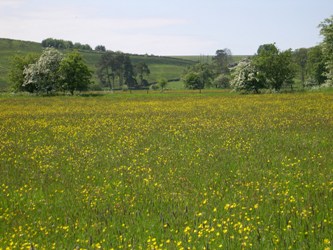Written by Abi Mansley of the Nectar Network project
Images courtesy of Northumberland National Park
Northumberland National Park has teamed up with Northumbrian Water and the Rees Jeffreys Road Fund to carry out a survey of the road verge around Kielder Water. The aim is to identify the best areas for pollinators and how to protect them.
Kielder Water is Europe’s largest man-made lake, constructed in the 1970s. The road, built up at the same time, needed soil in places to form verges. The soil was taken from good quality meadows, in the area now under water – so there are some stunning areas with a history to tell at the same time.
The verges stretch for an amazing 19 miles between Kielder and Falstone, and as they are quite wide in places they add up to 43 hectares! They make an excellent corridor to help species like the particularly iconic species in Northumberland National Park – the mountain bumble bee – which likes the nectar of moorland plants such as bilberry and heather, but at other times of the year looks for upland hay meadows and willow scrub to fill any ‘hungry gaps’. The verges can act like ‘service stations’ for them, to refuel between sites. However, in places the verges are getting taken over by scrub – so the project is to find out how to improve the verges for pollinators. The survey will take place three times between April and August this year.
The survey is looking for areas that are particularly flower-rich and will make recommendations aimed at keeping them that way. The best areas could even become a “seed bank” where volunteers can collect seed at harvest time to be scattered at other sites nearby, or grown on for replanting next year. On some verges, the Border Uplands project will seek further funding to make green hay or remove self-seeded trees which are shading out some flower-rich areas. This will give pollinators a nutritious highway to move about the uplands, and will provide an opportunity for pollinating plants to colonise new places to support more pollinating species.

Some of the lessons learnt so far on the project have been:
- Mapping the verges (using OS MasterMap) then first needs ground-truthing – some turn out to be forest rides, and other verge areas need adding in to the survey. Also the verges need dividing into manageable sections using some feature on the ground.
- What is interesting to people (e.g. orchids) may not always be the most interesting to pollinators. Some of the best flowers for bees and butterflies are ones which are often overlooked because they are common, such as red clover, yellow rattle, bird’s foot trefoil and the early pollen on shrubs like goat willow, or autumn foraging on ivy. Native bees and plants have evolved together; long-tongued bees prefer different shaped flowers to short-tongued species. Native bees are valuable pollinators, not only for wild flowers but even for many of our agricultural crops. In the UK there are around 267 species of bee – mostly solitary bee species – and 2,600 species of butterfly and moth.
- How to approach prioritising (with pollinators in mind) the verges with any identified practical work. We developed a score based on the species present – this took into account a range of species that are nectar rich as well as a range of species that are early and late nectar sources.
- Although the survey will carry on to late summer, volunteers need to be ready before the final survey, in August, to collect any seed. There needs to be a plan in advance for which species need to be collected and where they will be scattered or grown on. The survey will help them know which verges have the target species and are strong enough to be a seed bank.
- As a result of publicising the project, more history of the verges has come to light, thanks to members of the public getting in touch – which adds to the picture. It is possible some verges were seeded as well as the original meadow soil, although it is unlikely there are records about exactly what and where.
The survey at Kielder is part of the Border Uplands initiative, which looks to coordinate improvements for nature beyond boundaries. Recommendations from the Natural Environment White Paper showed that partnerships need to work together to bring about wildlife corridors or stepping stones to help nature be more resilient. Neighbouring Northumberland National Park farms with well managed upland hay meadows are part of this High Value Nature farming.
For more information contact abi.mansley@nnpa.org.uk



Notes
William Rees Jeffrey led the campaign to seal the nation’s roads, so improving travel for users, and was a major force in developing the national road classification system. Following his death in 1954 his estate provided the endowment which has enabled the Rees Jeffreys Road Fund to offer financial support to education, research and road transport-related projects.
